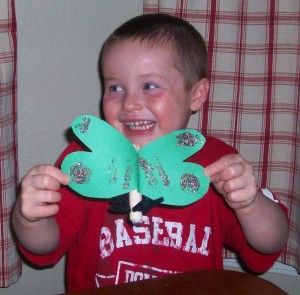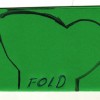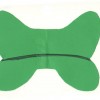You can use a butterfly wing craft to teach camouflage.

![]() First prepare a butterfly wing for each child. This can be done by folding one-fourth of a sheet of green construction paper in half.
First prepare a butterfly wing for each child. This can be done by folding one-fourth of a sheet of green construction paper in half.

![]() Draw the wing pattern shown, and then cut it out.
Draw the wing pattern shown, and then cut it out.
![]() Cut a large leaf from the remaining section of the green construction paper.
Cut a large leaf from the remaining section of the green construction paper.
Kids Can Do this:

1. On one side of the wing, use a crayon to draw a line to separate the upper and lower sets of wings.

2. Using a crayon, draw four large dots on the upper (top) set of wings as shown and two dots on the lower set of wings. Each pair of wings should be identical.Note: You can use colored stickers instead of drawing with crayons.
Glitter Method
Caution: Glitter can cause injury if inhaled or it gets into eyes. Paper circles cut with a paper hole punch can be used instead of glitter. See Paper Circle Method below.

* Using an art brush, put a tiny bit of glue on each dot. (It won’t matter if they make it big–but it is good to encourage them to make skilled use of the art brush.)
* Lay the wing in a container with a small amount of glitter in it. Kids can pick up the glitter with their fingers and sprinkle it on the glue covered spots. They can shake the excess glitter off into the container.
* Keep the wings open and allow them to dry.
Paper Circles Method
* Using a paper hole cutter to cut tiny circles from different colors of paper.
* Instead of glitter, sprinkle the paper circles on the glue spots.

Camouflage Lesson
1. Lay the open wing, colored side up, on the green leaf. Notice that parts of the wing blend in with the green leaf, but the colored dots are easy to see.
2.Fold the wing in half so that the colored dots are together. Then lay the folded wing on the green leaf. Notice that the folded wing is difficult to see.
Sum It Up!

Butterfly wings are more colorful on the top side than on the underside. The wings areopen when they fly and also when they need to warm up in sunlight. Birds eat butterflies and if a butterfly is on a leaf, a bird can see it better if its wings are open.
Butterflies close their wings when they are standing. With their wings closed, the coloring and patterns of the underside of the wings blends in more with the colors of things around them.
Note: The diagram shows the butterfly laying on its side. Butterflies do not lay down like this. It is an example of how the coloring of the wing’s underside blends in with the color of the leaf. Camouflage means to blend in with the background making the object difficult to see.
NOTE: The young boy in the diagram has added a clothes pin for the butterflies body and black craft stems for its antennae.
DARE TO BE CREATIVE!
The book is designed to help young students catch the “science bug”
Teaching the Fun of Science to Young Learners
The book’s 75 lessons and reproducible activities touch on all areas of science and provide the key to a world of science magic and mystery. While kids will have fun doing the activities and learning to love science, they are also being encouraged to develop other skills, including reading, writing, math, and art.
(Paid Link)
